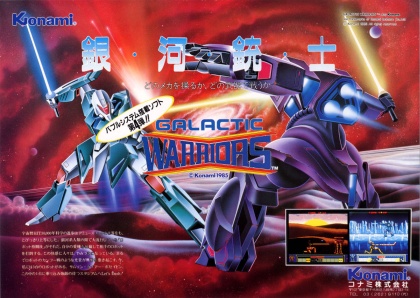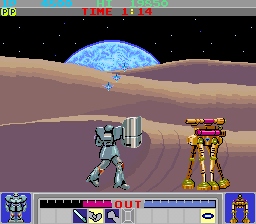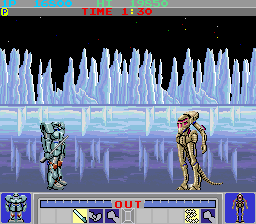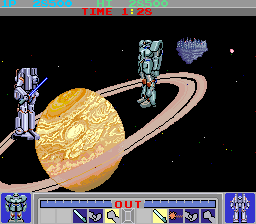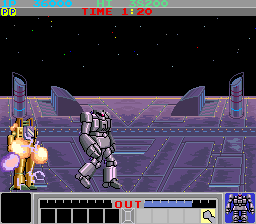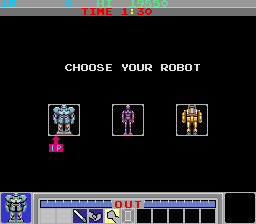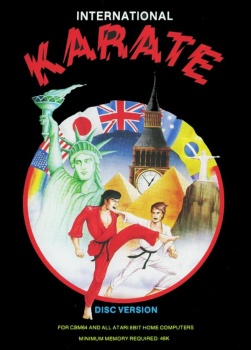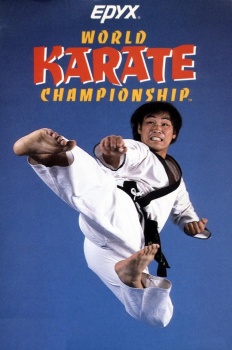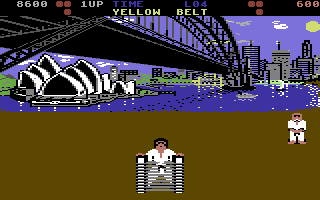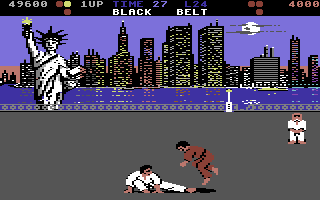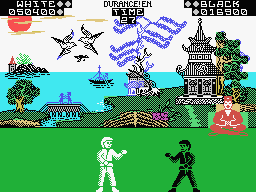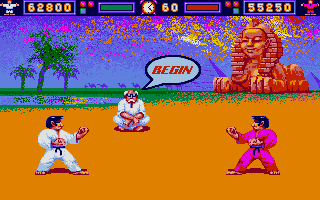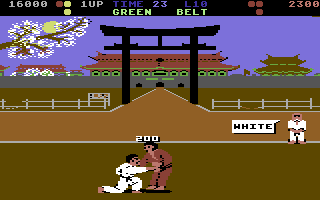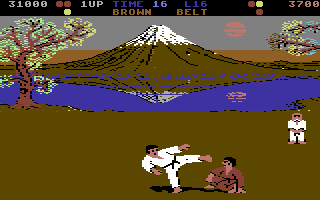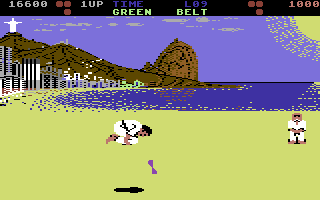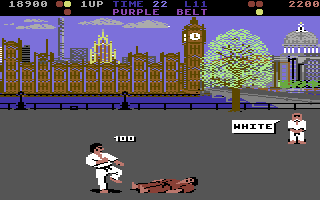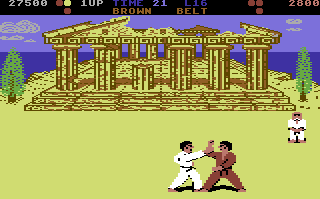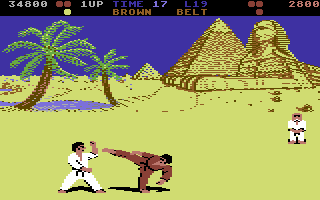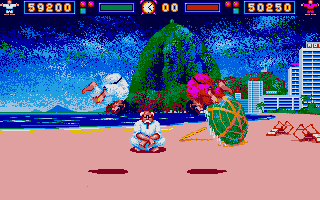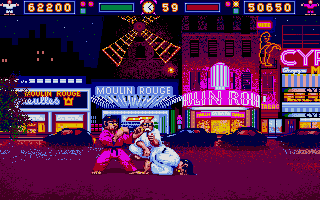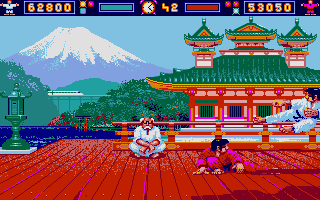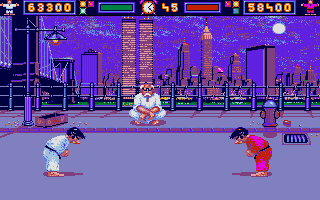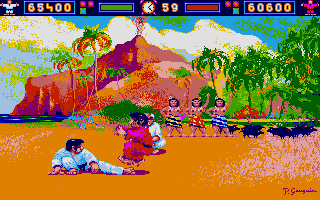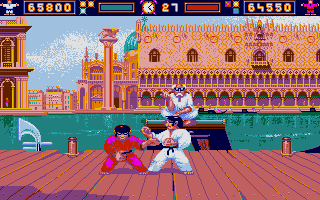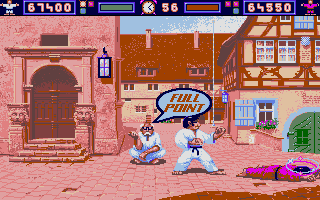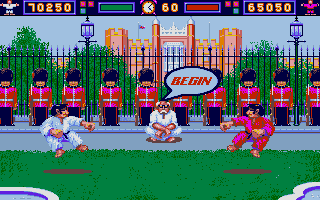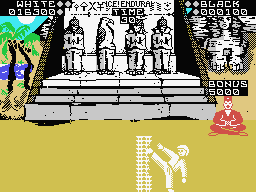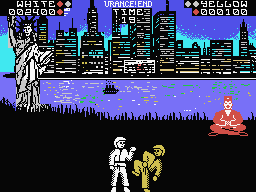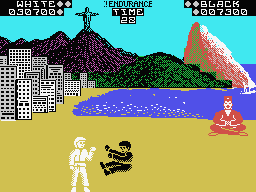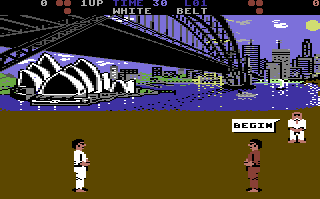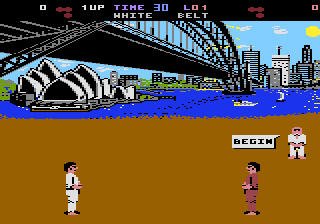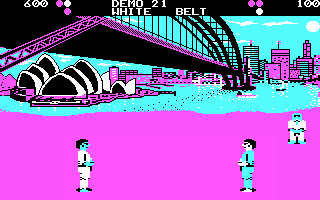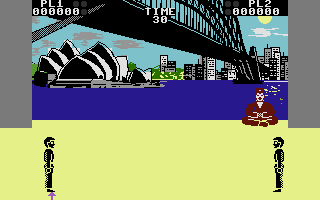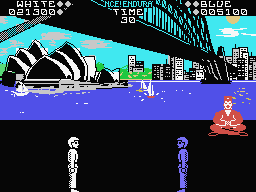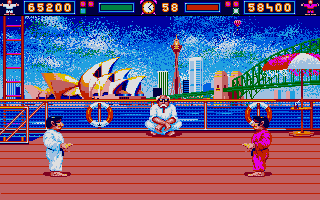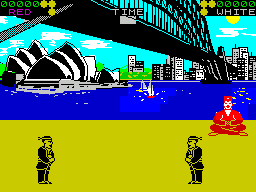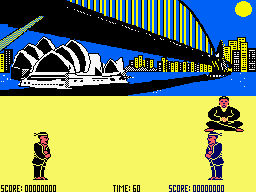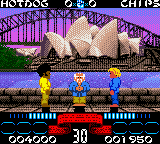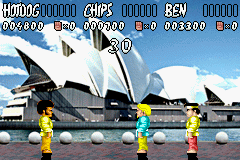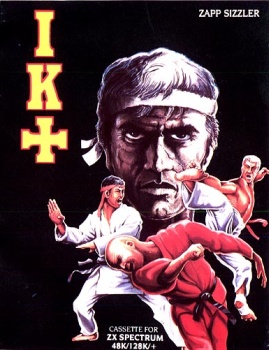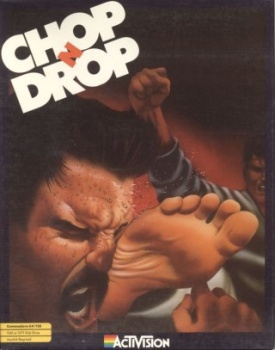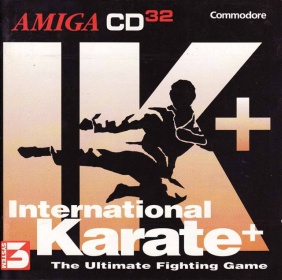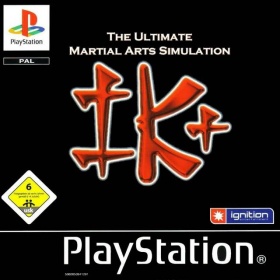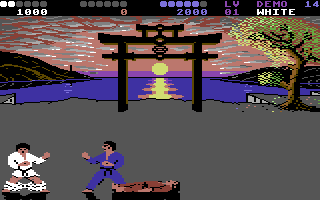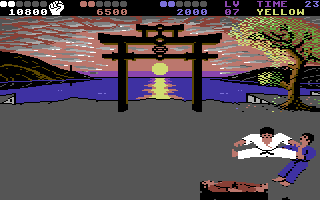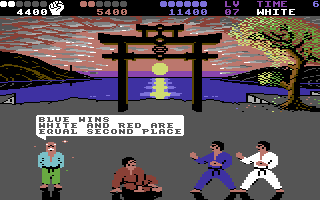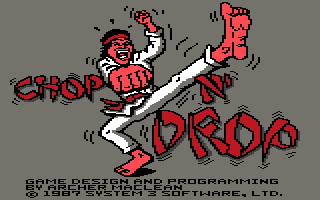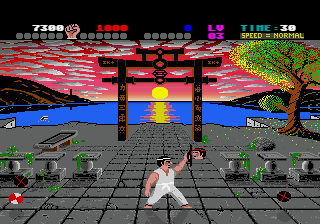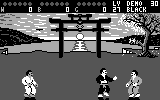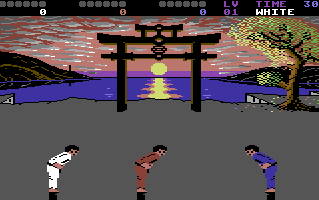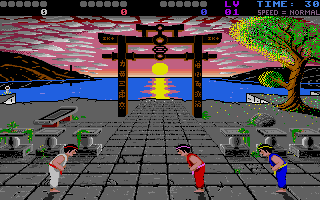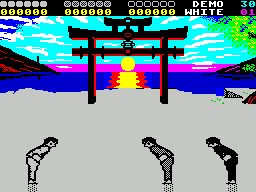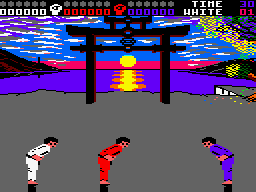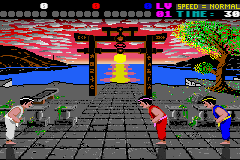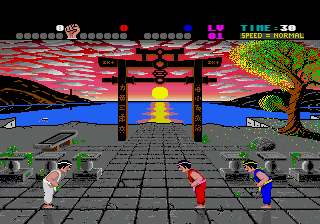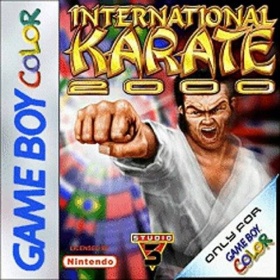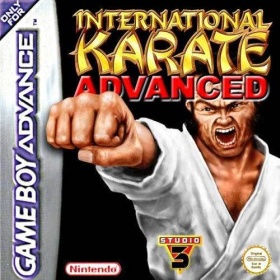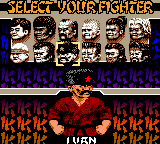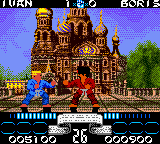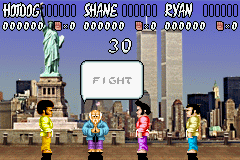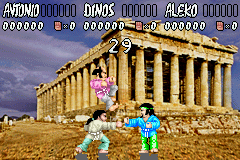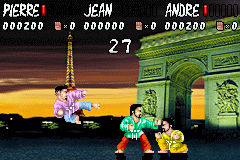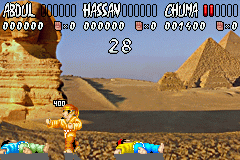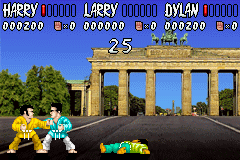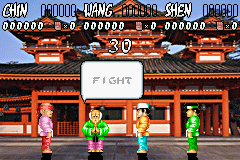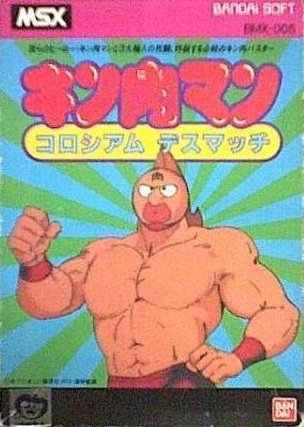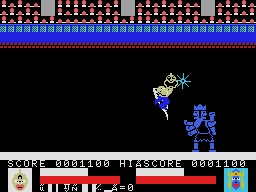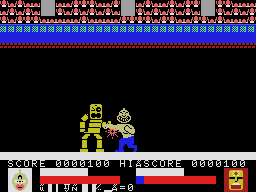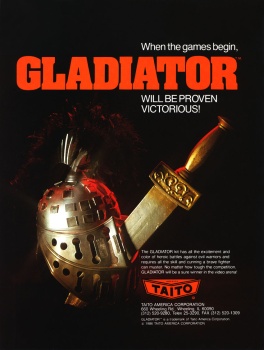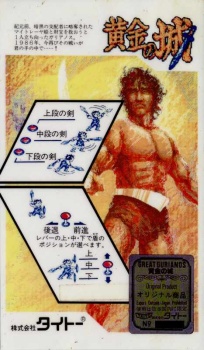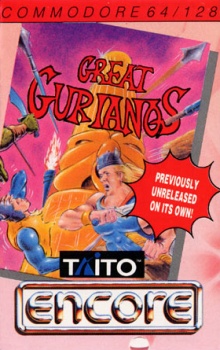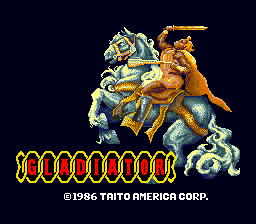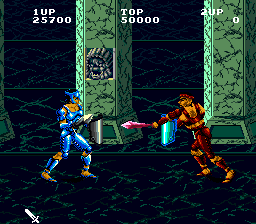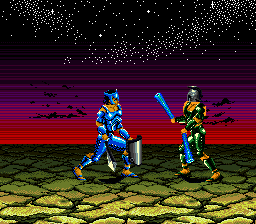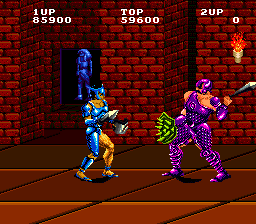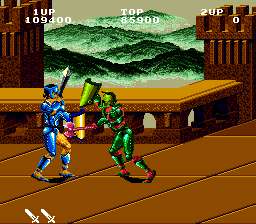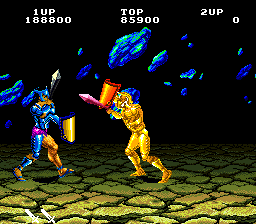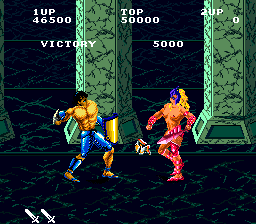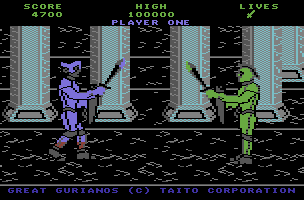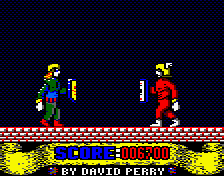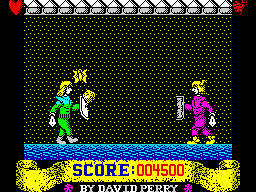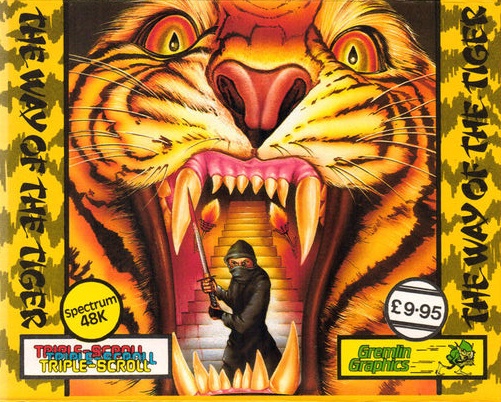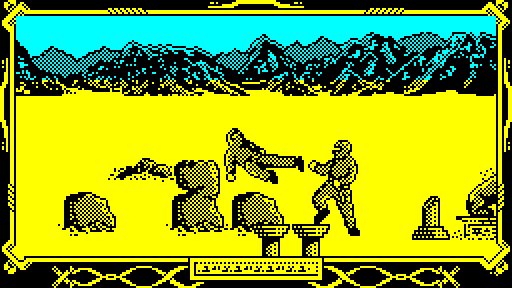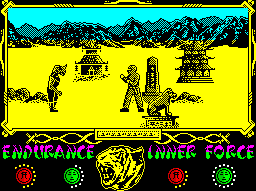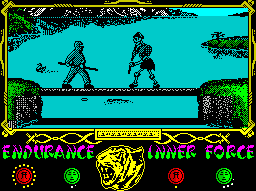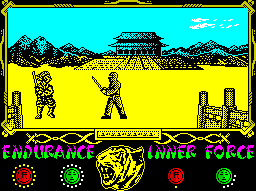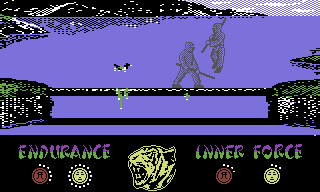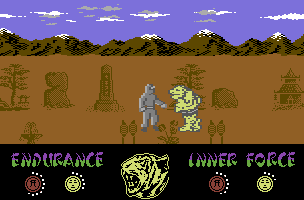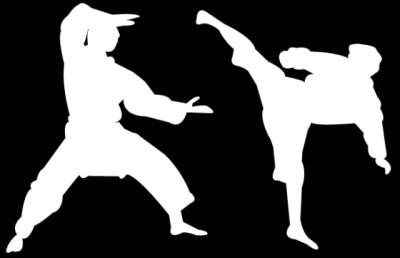
Pre-Street Fighter II Fighting Games
|
Page 1: |
Page 2: |
Page 3: |
Page 4: |
Page 5: |
|
Page 6: |
Page 7: |
Page 8: |
Page 9: |
Page 10: |
|
Page 11: |
Page 12: |
Galactic Warriors by Konami is the first fighter to feature multiple playable characters with individual movesets and properties. It also introduces block damage, air blocking, projectile attacks, a modern "analog" health bar (as opposed to a health meter comprised of notches), the ability to execute multiple attacks while airborne, and attacks of varying levels of strength. It's amazing how a game this innovative (made by Konami of all developers) could end up totally forgotten.
There are three playable characters: Samson, A mid-sized robot with a sword; Gaea, a "female" robot with breast projectiles(!); and Poseidon, a bulky robot with an extendible limb. All of the characters move slowly and rebound off each other when they make contact. It seems Konami wanted to make the battling robots feel more real with these features, but they just make the movement awkward. The game uses three buttons. Inspired by Sega's Champion Boxing, one cycles through three different kinds of attacks: a punch, a kick, and a third attack unique to the character. This switch system isn't very intuitive and the game would be much more playable if it just had three separate attack buttons. The second button executes the currently selected attack. The last button raises the characters' shields to block.
The game also puts several non-playable bosses in the player's way to victory. Each of them has an original design and an unique attack. Most of the bosses are manageable, but the second to last boss is impossible. The last battle is a mirror match against the same robot as the player uses. After defeating the final boss, the game loops to the beginning, and the player character and every boss are given an extra weapon.
International Karate / World Karate Championship - Commodore 64, Amstrad CPC, Commodore Plus/4, ZX Spectrum, MSX, Atari ST, IBM PC (1985)
International Karate marks the beginning of Way of the Exploding Fist plagiarism. Curiously, early versions of the game have been shown running before Beam Software's title was released, but it got delayed several times, and the end product looks indeed very suspiciously similar.
There are hardly any differences between this game and Exploding Fist, at all. They both have the exact same gameplay. Even the fighters look like redrawings of the exact same sprites. The only obvious feature to distinguish International Karate from its forebear are the backgrounds, which take players to famous locations all over the world, true to the game's title. All the big fighting game series revolve around ominous international martial arts tournaments, be it Street Fighter, The King of Fighters, Virtua Fighter or Tekken, and this is where the trend started. There are a total of eight different backgrounds, compared to Exploding Fist's four. The music was composed by Rob Hubbard, a very popular composer among C64 music fans. He was later responsible for the music in Bangkok Knights, Budokan, Skate or Die, and Road Rash.
Ironically, it wasn't Melbourne House, publishers of Exploding Fist who sued over International Karate, but Data East. The distributor for Karate Champ went into litigations against Epyx after they published Melbourne House's game as World Karate Championship in the US. The district court at first declared the game infringing on Data East's copyright and ordered Epyx to recall the product. The defendant appealed, though, and it was ultimately ruled that most of the similarities of the game were dictated by them both being a simulation of the sport karate, and by the constraints of the technology, thus International Karate was officially not infringing on the copyright for Karate Champ. The similarities where listed as follows:
A. Each game has fourteen moves.
B. Each game has a two-player option.
C. Each game has a one-player option.
D. Each game has forward and backward somersault moves and about-face moves.
E. Each game has a squatting reverse punch wherein the heel is not on the ground.
F. Each game has an upper-lunge punch.
G. Each game has a back-foot sweep.
H. Each game has a jumping sidekick.
I. Each game has low kick.
J. Each game has a walk-backwards position.
K. Each game has changing background scenes.
L. Each game has 30-second countdown rounds.
M. Each game uses one referee.
N. In each game the referee says "begin," "stop," "white," "red," which is depicted by a cartoon-style speech balloon.
O. Each game has a provision for 100 bonus points per remaining second.
(source)
The only thing that really can be traced directly to Karate Champ are the bonus rounds. One makes the player avoid several objects thrown across the screen like in Technos' classic. The other is a brick-breaking challenge, although the only requirement seems to be to hit the fire button once as fast as possible after the referee gives his signal.
Despite being a complete copy of Exploding Fist, International Karate became way more popular. Not only did it look and sound better, it also was more balanced than Exploding Fist, where the same move would fool the CPU over and over again. It was among the most popular fighters outside of Japan until Street Fighter II was released.
The different ports vary greatly. The Atari 8-bit version is middle of the road in terms of sounds and visuals. The ZX Spectrum version is the worst in every respect. The Amstrad CPC version is bad to the point of being unplayable. The MSX and IBM PC fare not much better. The Commodore 64 version is the best of the 8-bit versions by far.
The Atari ST version could almost be considered a remake. It looks way more high end, but replaces the original aesthetics with a more cartoonish look. Not only do the characters have extraordinarily pronounced ears and noses, they also have a few different goofy reactions depending on what part of the body they're hit. All previously existing graphics are redrawn, some backgrounds are merged together to make way for a couple new ones, amounting to a total 10 stages. Some have even added spectators, like the royal guard in London or topless dancers in Hawaii.
All in all, International Karate is quite a decent game. It's probably better than Exploding Fist, thanks to slightly smoother controls and better balancing.
Quick Info:
|
Developer: |
|
|
Publisher: |
|
|
Designer: |
|
|
Genre: |
|
|
Themes: |
International Karate (Commodore 64)
International Karate (Commodore 64)
International Karate (MSX)
International Karate (Atari ST)
Additional Screenshots
Comparison Screenshots
IK+ / Chop N' Drop / International Karate+ - Commodore 64, ZX Spectrum, Amstrad CPC, Atari ST, Amiga, Amiga CD32, PlayStation, Game Boy Advance, Wii (1987)
Internatioal Karate soon received an updated version with IK+. Now three combatants would compete in each match, although only two can be controlled by human participants. Also new are a few "cool" moves, like a back flip, a head butt and a [Spagat]-kick in both directions at once.
The scoring system was also changed a bit, so now the fight goes on when a character is downed, awarding one or two points to the opponent who struck the blow. Whoever reaches six points first (or has the most when time runs out) wins. A runner-up still stays in battle, while a player who comes in last is removed from the game.
The lone bonus round now provides the winner of a match with a shield, which he has to move between six positions (up/middle/down on each side) to deflect balls that keep bouncing from off-screen. It's much more original and a lot more fun than the offerings in the previous title.
Not everything is an improvement, though: Inexplicably, IK+ only has one single background, nothing much "international" here (which might be the reason why most versions where only labeled with the acronym). At least the background is particularly pretty. There is also a hidden animation of the fighter dropping his pants when simultaneously pressing S and E on the keyboard. The music is once again by Rob Hubbard, but it sounds a lot more dynamic than the rather laid-back tune from the first game. It has samples taken from Bruce Lee's movie Enter the Dragon.
As with damn near any fighter release on the computer, the ZX Spectrum port of this game was not very good. However, the Amstrad CPC is pretty much like the others, unlike most of the fighters released on the platform. The Commodore 64 version is as usual the best 8-bit variant and was retitled Chop n' Drop for the American release. The Amiga and Atari ST versions are identical and slightly better looking than the Commodore 64 version with the same gameplay. This base version was later also remade for the PlayStation and Game Boy Advance
Several years after the commercial death of the C64, inventive modders have come up with a 4-player joystick adapter for the computer, followed by a hacked version of this game known as IK+ Gold, which finally allows a third player to take control of the blue karateka.
Quick Info:
|
Developer: |
|
|
Publisher: |
|
|
Designer: |
|
|
Genre: |
|
|
Themes: |
IK+ (Commodore 64)
IK+ (Commodore 64)
Chop N' Drop (Commodore 64)
IK+ (PlayStation)
IK+ (TI-89)
Comparison Screenshots
International Karate 2000 - Game Boy Color (2000)
International Karate Advanced - Game Boy Color (2001)
International Karate 2000 for the Game Boy Color port is a complete reimagening of the original, with very different gameply. The best improvement is that the characters face each other at all times, removing the problem of moves that turn them around. Attacks are still executed by tapping a direction and a button at the same time, but are performed slightly differently. Another change is the addition of a health bar. Getting in a hit after the health bar is depleted results in a knock down, which can be worth a half point or a whole point. The first player to score three points wins the round. There are now 12 characters with individual heads and gi colors, but as far as the gameplay is concerned, they're still all essentially the same guy.
A year later arrived International Karate Advanced. The gameplay is mostly the same as the GBC predecessor, but it uses the three-combatants mode from IK+. The backgrounds look like their elements were cut out from photos, and they really don't mesh well with the charactrer sprites.
Quick Info:
|
Developer: |
|
|
Publisher: |
|
|
Genre: |
|
|
Themes: |
International Karate 2000 (Game Boy)
International Karate 2000 (Game Boy)
Additional Screenshots
Kinnikuman Colosseum Deathmatch is based on a manga/anime franchise that is mostly known in the West for a line of toys called "M.U.S.C.L.E.". The first video game based on Kinnikuman is a fighter for MSX where a single player must fight past three opponents, after which the game loops. Matches consist of only one round, health is measured with a health bar, up jumps, down ducks, and it's possible to attack from those positions or while standing, and execute a throw. There's also a bizarre, and far too risky, technique where you jump against the wall, tap the direction toward the wall and then attack, making the character bounce off the wall; damaging the opponent if the move connects, or hitting the ground and taking damage if it does not. Lastly, the game is noteworthy for being the first fighter with air throws. It seems like this could have been decent, but control responsiveness is poor, and often nothing happens even after repeated presses of a button. Despite this last problem, it's a pretty easy game, so it's definitely worth playing through as a curiosity.
Quick Info:
|
Developer: |
|
|
Publisher: |
|
|
Genre: |
|
|
Themes: |
Kinnikuman Colosseum Deathmatch (MSX)
Kinnikuman Colosseum Deathmatch (MSX)
Gladiator / The Great Gurianos / Ougon no Shiro (黄金の城) - Arcade, Commodore 64, ZX Spectrum, Amstrad CPC, PlayStation 2, Xbox, Windows (1986)
This game plays kind of like a much faster version of Great Swordsman, though you have a shield for blocking. In between enemies, there are also scrolling sections similar to Yie Ar Kung-Fu 2, where projectiles keep flying at the player, who has to deflect them with the shield. There are three buttons that will attack high, straight, or low. The shield is at mid level when the joystick is at neutral or while moving, and can be moved up or down by holding the joystick in that direction. By moving the joystick up and down rapidly, a force field appears and protects the character temporarily. This move can only be executed once per level. There are no life meters in Gladiator. Instead, when a character is hit a piece of their armor breaks off. If the fighters are hit where they no longer are wearing armor, they are killed. In a way, this hit system is an early example of fatalities in a fighter. The shield and sword can also absorb hits, but break when they take too much damage.
The biggest problem with Gladiator is the difficulty. Other than the first few guys, opponents block every attack thrown at them. Their shields can be damaged, but this doesn't do a thing to make it any easier. In the Japanese version, the female gladiator's bare breasts are visible when her chest plate is destroyed.
Gladiator got ported to the Commodore 64, Amstrad CPC and ZX Spectrum, under the European name Great Gurianos, only released on compilations and through a low budget label. Neither of them is very good, chiefly because the player is stuck with either keyboard controls or a really inconvenient joystick scheme that requires the function keys on the keyboard to control the sword. But the hit detection is also bad, and instead of losing armor characters simply turn red at damaged parts. The Spectrum and Amstrad versions notably were programmed by one David Perry of later Shiny Entertainment fame, who hilariously made the final boss invincible because there was no memory space for the ending left.
Quick Info:
|
Developer: |
|
|
Publisher: |
|
|
Genre: |
|
|
Themes: |
Gladiator (Arcade)
Additional Screenshots
Computer Versions Screenshots
Gremlin Graphics created a number of fighting games in the '80s, although none of them are any good. (This game was followed by Samurai Trilogy and Hercules: Slayer of the Damned. See final page for screenshots.) The Way of the Tiger, too, would be just another talentless pupil of the Exploding Fist school, if it wasn't for one innovation: It is the first game to simulate several different disciplines: Hand-to-hand combat, pole fighting and swordfighting. The first is standard Exploding Fist fare, but the weapon-based parts put a greater emphasis on blocking.
Each discipline can be practiced individually, to prepare for the main mode, where the game alternates between the three. The fights take place in scrolling stages, where new enemies keep appearing one at a time. They range from ninjas to skeleton warriors and some nasty gnomes, who can turn into ghosts and are really hard to hit in either form. The pole fighting scene is very obviously inspired by the scene in The Adventures of Robin Hood with Errol Flynn - it even takes place on a tree trunk above a river.
Everyone in The Way of the Tiger has two health bars, represented as dots around a circle. Every time Endurance is depleted completely, it is refilled by sacrificing one dot of Inner Strength. This only results in both the player and the later enemies having ridiculous amounts of health, without adding anything else to the game. The hit detection is horrible, so it's nearly impossible to hit an opponent without getting hurt as well, and the sheer number of enemies that spawn one after another are more than enough to wear the player down.
The Way of the Tiger (ZX Spectrum)
Gremlin Graphics programmed the game for the whole range of 8-bit computers available in the UK, but the differences between them are minimal. They merely vary in the amount of colors, the depth of the parallax scrolling and the abundance of animated back- and foreground objects. Needless to say, the C64 wins in every regard. There is also a sequel called Avenger, which abandons the fighting genre and takes the form of a top-down view action adventure.
Quick Info:
|
Developer: |
|
|
Publisher: |
|
|
Genre: |
|
|
Themes: |
The Way of the Tiger (ZX Spectrum)
The Way of the Tiger (ZX Spectrum)
The Way of the Tiger (ZX Spectrum)
The Way of the Tiger (Commodore 64)
The Way of the Tiger (Commodore 64)
|
Page 1: |
Page 2: |
Page 3: |
Page 4: |
Page 5: |
|
Page 6: |
Page 7: |
Page 8: |
Page 9: |
Page 10: |
|
Page 11: |
Page 12: |
